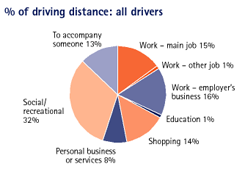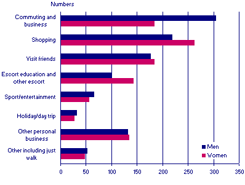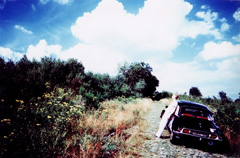RM , required transportation by mode. These journeys consist of travel for which no viable alternative exists. Required means there is no choice involved in the journey, as opposed to travel by desire. Examples are emergency services, goods deliveries, land surveyors etc. Perhaps in time things like the postal service could be entirely replaced by electronic media, but it is unlikely that the transportation of goods and emergency services will be replaced by non-motorized individual transport soon. Thus, this is a category which is usually unwise to restrict. This poses certain interesting challenges for the pedestrianized city areas since they will always, at any time, require access by these RM types of travel, since it is the mode, not the destination or origin, that defines its nature. Attention to these types of travel are highly important for urban planning contexts where pedestrianization is a large component. One can accommodate for some RM travel by, for instance, providing dedicated ambulance and fire engine routes.
RD, required transportation by destination, are journeys that are required but for which the mode is not predefined. Travel such as work and school commute, gathering required goods for living, and administrative tasks fall into this category. The majority of travel takes place in this category, and it should be the focus of intervention. The profiles of the different types of RD travel change per country, as for instance New Zealand’s education travel is almost non existent but makes up a significant amount of the total travel in Great Britain (fig 1 & 2). RD type travel can be reduced significantly in the first order by applying an alternative destination or point of origin. This could mean work at home for commuting, moving closer to work, using a local school, setting up online administration centers instead of physical offices, and so on. Secondary, this type of travel can almost always be converted in mode. One can take public transportation in many cases for this type of travel instead of the car. Where the first, alternative destination, can be hard to execute, it is something we as a society can work towards, and in the meantime we can execute efforts to implement the second intervention. The diagrammatic method offers more possibilities to deal with this category.
DD travel is a desire travel, one which is not necessary for normal life, and is therefore mostly irregular in nature. Think vacations, visiting friends, any voluntary travel to reach a certain destination. It is not so that this type of travel should be discouraged. Visiting friends, going to the park or other leisurely travel is vital to a vibrant city life and should be accommodated for as much as possible. Nonetheless, some type of DD travel could be discouraged in favor of others. Flying to remote corners of the world each year for recreational purposes is problematic from an energy stand point, for instance, and could easily be replaced by more modest travel needs. Also, one could provide for more decentralized services such as more, smaller education and sports facilities instead of just a few large ones to reduce travel times an thus allow for more flexible mode switching. Of course for DD the switching of mode is also the easiest to accomplish and those kinds of interventions can be readily implemented. DM, desired travel by mode, is a more problematic kind. It's a voluntary type of travel chosen for its mode, notfor its destination. Think road trip. It’s a small contender in this framework but one which has roots that affect RD and DD as well. The main problem with DM when the mode is the car is that it is the car itself which provides the reason for travel, often there not being a destination. It is something present and thoroughly embedded in many western cultures, from cruising down the strip to transcontinental car explorations. It is very difficult to provide a replacement for these kind of travel, since the personal space a car offers, the feeling of freedom and the cultural associations that have sprung up around the car, mainly in the United States, are hard to overcome. Still, one should consider that less that one century ago culture and humanity was very able to do without the car, and it should not be hard to envision that the future does not necessarily include personalized motorized transport either. Ways of reducing DM type of travel is by providing quality alternatives, such as sufficient parks so one can be alone in a beautiful environment, and discouraging the use of the car as a form of entertainment, such as for instance with economical incentives (congestion charging), protecting natural areas by only allowing residents with passes, such as happens in the Netherlands, and so on. |

fig 1. 1998-1999 New Zealand Ministry of Transport survey |

fig 2. National Travel Survey, 1999-2001, Department for Transport; Road Casualties Great Britain 2002, Department for Transport |
|

DM: Desire travel by Mode |
|